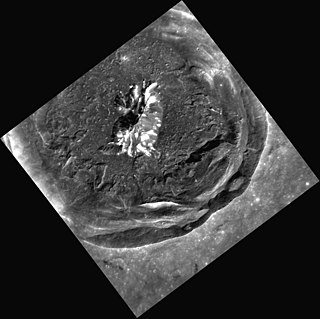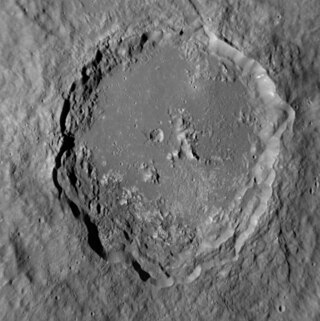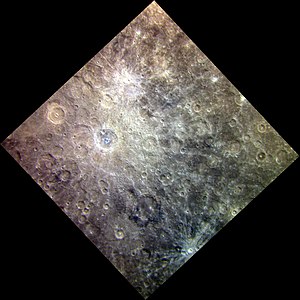
Matisse is an impact crater on the southern hemisphere of Mercury. Matisse takes its name from the French artist Henri Matisse, and it was named by the IAU in 1976.

Eminescu is a peak ring crater on Mercury 125 kilometers (78 mi) in diameter. Since there are very few later craters superposed on it, Eminescu appears to be a young crater formed around one billion years ago. It has a transitional morphology between larger more complex impact basins like Raditladi and smaller simpler central peak craters.

Xiao Zhao crater is small in comparison with many other craters on Mercury. However, Xiao Zhao's long bright rays make it a readily visible feature. The fresh, bright rays, which were created by material ejected outward during the impact event that formed the crater, indicate that Xiao Zhao is a relatively young crater on Mercury's surface.

Atget crater is distinctive on the planet Mercury's surface due to its dark color. Atget crater is located within Caloris basin, near Apollodorus crater and Pantheon Fossae. The dark color of the floor of Atget is in contrast to other craters within Caloris basin that exhibit bright materials on their floors, such as the craters Kertész and Sander. Other craters on Mercury, such as Bashō and Neruda, have halos of dark material but the dark material does not cover the crater floors.

Cunningham is a young crater on the western floor of the Caloris Basin, on Mercury. It is surrounded by a bright ray system.

Sander is a crater on Mercury within Caloris Basin. It has dark walls and bright patches on its floor. Unlike the rays of Bashō crater, the bright areas are not believed to be immature, but they are inherently bright. It is named after the German photographer August Sander (1876–1964).

Amaral is a crater on the planet Mercury. With its smooth floor, surrounding ejecta, and small secondary craters, it appears noticeably younger than the heavily cratered surface around it. Along with a smooth crater floor, Amaral also has a central peak. Bright material on this peak is of particular interest as it appears to have an unusual color. In color-enhanced images, the central peak of Amaral appears as a bright blue color in striking contrast to the otherwise orange tones of surface material nearby. The different color of the central peak likely indicates rocks with different chemical composition from those on the neighboring surface.

Berkel is a crater on the planet Mercury. Its name was approved by the IAU on July 9, 2009. It was named after the modernist painter Sabri Berkel.

Nāwahī is a crater on Mercury. Nāwahī crater is located within the large Caloris basin, near the western rim. The unusual dark material creating a halo around Nāwahī makes this crater of special interest, as the dark material likely represents rocks with a different chemical and mineralogical composition than those of the neighboring surface. The crater is named after Hawaiian patriot and painter Joseph Nāwahī.

Alencar is a crater on Mercury. It has a diameter of 120 kilometers. Its name was adopted by the International Astronomical Union (IAU) in 1979. Alencar is named for the Brazilian novel writer José de Alencar, who lived from 1829 to 1877.

Bartók is a crater on Mercury. Its name was adopted by the International Astronomical Union (IAU) in 1979. Bartók is named for the Hungarian composer Béla Bartók, who lived from 1881 to 1945.

Bello is a crater on Mercury. It has a diameter of 129 kilometers. Its name was adopted by the International Astronomical Union (IAU) in 1976. Bello is named for the Venezuelan poet Andrés Bello, who lived from 1781 to 1865.

Balanchine is a crater on the planet Mercury. It possesses a ray system of slightly bluish rays. These rays inspired the name of the crater due to their similarity to the tutu in George Balanchine's Serenade.

Tyagaraja is a crater on Mercury. Its name was adopted by the International Astronomical Union in 1976. Tyagaraja is named for the Indian composer Tyagaraja.

Alver is a crater on Mercury. It has a diameter of 151.49 kilometers. Its name was adopted by the International Astronomical Union (IAU) on March 15, 2013. Alver is named for the Estonian poet Betti Alver.

Rustaveli is a crater on Mercury. Its name was adopted by the International Astronomical Union in 2012, after the Georgian poet Shota Rustaveli.

Castiglione is a crater on Mercury. Its name was adopted by the International Astronomical Union (IAU) on September 25, 2015. Castiglione is named for the Italian painter Giuseppe Castiglione.

Capote is a crater on Mercury. Its name was adopted by the International Astronomical Union (IAU) in 2013, and is named for the American author Truman Capote.

Zmija Facula is a bright region on the surface of Mercury, located within an unnamed crater that is itself within the larger Rembrandt basin. It was named by the IAU in June 2020. Zmija is the Serbian word for snake.

Mendelssohn is a crater on Mercury. Its name was adopted by the International Astronomical Union (IAU) on April 24, 2012. Mendelssohn is named for the German composer Jakob Ludwig Felix Mendelssohn.























